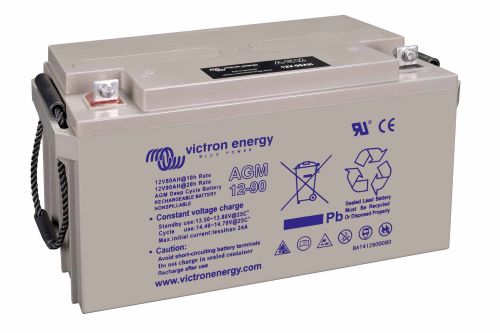Table of Contents
AGM Batteries: The Cheap, Maintenance Free Solar Battery
AGM batteries became popular in the early 1980s as a battery for military aircraft, because they were lighter and more reliable than flooded lead acid batteries. Today, they’re used for solar as well.
What is an AGM battery?
AGM batteries are deep cycle batteries. In a deep cycle battery, you can use more of the battery’s energy, up to 50% for AGM. Shallow cycle batteries like car batteries give you less energy, typically only 20%.
AGM stands for Absorbent Glass Mat. This is because the batteries have a fiberglass mesh that contains the electrolyte and separates the battery plates.

AGM vs flooded lead acid batteries
The key difference between AGM and flooded lead acid is maintenance. Flooded lead acid batteries lose water through normal use. Water you must replace every 1-3 months. AGM batteries don’t lose water which means there’s no need for you to replace it.
AGM is a valve-regulated battery. It releases hydrogen, though far less than flooded lead acid, through valves. Since they release less hydrogen, they don’t need as much ventilation. This makes them a safer battery than flooded lead acid. Hydrogen in an enclosed area is combustive.
Flooded lead acid batteries need an equalizing charge to prevent sulfation. Sulfation is a chemical process that reduces a batteries capacity. AGM batteries are less prone to sulfation and thus don’t need an equalizing charge.
Because an AGM battery traps almost all the electrolyte inside the battery, it provides more usable energy. You can use up to 80% of its capacity. 50% is still recommended to prolong the battery life, however. Flooded lead acid gives you 50% of usable energy.
AGM batteries can be installed in any orientation whereas flooded lead acid batteries can only be fitted upright.
AGM is also a lighter battery and charges up to 5 times faster than flooded lead acid. For all the advantages you get with AGM over flooded lead acid they are naturally, more expensive.
Here’s a comprehensive guide to flooded lead acid batteries for comparison.
AGM vs gel batteries
Although they’re both sealed lead acid batteries there are a few differences between Gel and AGM you need to know if you’re looking at buying a sealed lead acid battery.
AGM batteries have a shorter lifespan. They have a 4-year lifespan while gel has a 6-year lifespan. AGM batteries can however, handle higher loads since they have a lower internal resistance. They’re also typically cheaper than gel and they do better in low temperatures.
Here’s a complete guide to gel batteries for comparison.
Pros and cons of AGM batteries
What are the advantages and disadvantages of AGM batteries compared to other solar batteries?
Advantages of an AGM battery
- It can be charged with an ordinary car battery charger.
- Charges up to five times faster than a flooded lead-acid battery.
- Better performance in cold temperatures.
- Spill-proof battery which allows you to install it sideways.
Disadvantages
- Gel batteries maintain their capacity for longer.
- They’re more expensive than flooded lead batteries.
- Shorter lifespan than gel.
When should you choose AGM?
Gel or AGM can be used in an off-grid home or as battery backup in case of load shedding or blackout.
Choose AGM batteries if you want a cheaper lead acid battery that can handle higher loads and doesn’t need maintenance.